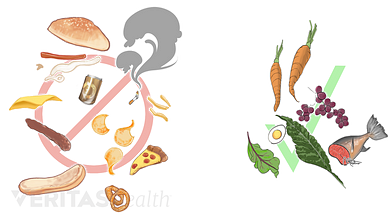
IBS-friendly fruits include those with high fibre. Apples, pears, and stone fruit have high levels of fructose, a common cause of abdominal pain. Bananas, citrus, berries, and dried fruit are all low in fructose. Avoid cruciferous vegetables such as broccoli and cauliflower which are high in sulfur. IBS sufferers should avoid eating onions.
IBS patients should not eat oranges. They contain too much citric acid, which can cause irritation. Kiwis, however, are much more suitable for IBS because they contain a lot less sugar than oranges. Although strawberries and apples are excellent sources of Vitamin C (as well as other fruits), they have a high level of fructose that may cause IBS flareups.
High fiber fruit are preferred. These fruits are rich in insoluble fiber, which may irritate the IBS intestine. In addition to this, peeling fruit can help to reduce the severity of symptom flare-ups. There are many types of fruit that are suitable for those with IBS, so you can find the ones that are good for you. They can be a good source of vitamins or minerals.

Passion fruit can be enjoyed in moderation as a source of soluble fibre. However, it should be eaten along with other fruits rich in soluble fiber. You will also find FODMAP-rich fruits. You can also use the Monash University FODMAP app to get an idea of how much fiber is in different types of fruit. If you like fennel, consider adding some of its seeds to your diet. This can help with constipation.
IBS symptoms can be aggravated by soda, high fructose corn syrup, and sodas. Fruits are also rich in fibers, including soluble fibers. IBS sufferers will find bananas and raisins especially helpful. Both are high in fiber, which can ease constipation. If you are unsure which foods are best for your health, you can start by eating a small amount of each. After you have determined which ones are the best, you can go ahead and give them a try.
People with IBS will love apple. Its fiber and vitamins help maintain proper digestion. And apple juice helps keep your gut healthy. Cumin herb can be helpful for people suffering from irritable bowel syndrome. It is well-known for its anti-inflammatory properties and antioxidant benefits. The seeds are anti-inflammatory and have carminative qualities. Cumin seeds are high in fiber and can help with irritable intestinal problems.
A fruit for ibs is another good choice. Apples are rich sources of fiber and vitamins that help maintain a healthy digestive tract. It is possible to reduce the symptoms of irritable stool syndrome by eating an apple every day. The cumin seeds may also be helpful in relieving symptoms. So, apples can be an excellent choice for you to eat for ibs sufferers.

Fruits are not only high in fiber but also have high levels of vitamins and minerals. Avoid sweets and other commercial snacks that are high in fructose. It is important to keep a food log in order to determine which foods should be avoided and which are safe. If you're unsure of which foods are triggering your symptoms, consult your doctor before introducing new foods.
IBS patients can benefit from eating lots of fruits, vegetables and other healthy foods. These foods are high in fructose and can worsen your symptoms. For this reason, you should avoid foods with high fructoses, such as soft drinks and processed foods. Your symptoms will not get worse if you eat a fruit with low levels of fructose.
IBS patients love easy-to-digest fruits. Blueberries are an excellent source of dietary fibre, such as blueberries. They can also help with digestion. They are also rich in vitamins and minerals. For ibs, you should eat fruit and vegetables all the time.
para: Other fruits for ibs that have an anti-inflammatory effect are fennel seeds and peppermint. They are also rich in dietary fibers and antioxidants.
FAQ
Why is it so important to lead a healthy lifestyle
A healthy lifestyle will help us live longer and happier lives. A healthy diet, regular exercise and good sleep habits will prevent the development of diseases such as heart disease, stroke, cancer, diabetes, and Alzheimer's.
A healthy lifestyle helps us cope better when we are faced with everyday stresses. Healthy living will boost self-confidence and make you look and feel younger.
What is the working principle of an antibiotic?
Antibiotics are drugs that destroy harmful bacteria. To treat bacterial infections, antibiotics are used. There are many different types of antibiotics. Some can be taken orally, others are injected and some are applied topically.
Antibiotics are often prescribed to people who have been exposed to certain germs. For example, if someone has had chicken pox, he or she might take an oral antibiotic to prevent shingles later on. Penicillin might also be administered to someone with strep throat. This will help prevent the possibility of developing pneumonia.
A doctor should give antibiotics to children. Children are more likely to experience side effects than adults from antibiotics.
The most common side effect of antibiotics is diarrhea. Other side effects possible include dizziness, nausea, vomiting, stomach cramps, dizziness and allergic reactions. These symptoms usually go away after treatment ends.
How often should you exercise?
A healthy lifestyle requires regular exercise. But, you don't need to spend a specific amount of time exercising. It is important to find something that you enjoy and stay with it.
If you are working out three times a weeks, aim to do 20-30 minute of moderate intensity. Moderate intensity means that your muscles will continue to work hard even after you finish. This type of workout burns around 300 calories.
Walking is a great option if you are a keen walker. You can do 10-minute walks four days per week. Walking is easy on the joints and has low impact.
You can also run for 15 minutes, three times per week. Running is a great exercise to build muscle tone and burn excess calories.
If you're not used to exercising, start slowly. Start by doing 5 minutes of cardio each day, a few times per week. Gradually increase your cardio time until you reach the goal.
How can I reduce my blood pressure
The first thing you need to do is find out what causes high blood pressure. You must then take steps towards reducing the problem. This could be as simple as eating less salt, losing weight, taking medications, etc.
Also, make sure to get enough exercise. If you don’t have enough time to exercise regularly, consider walking more often.
You should join a gym if you are unhappy with your exercise routine. A gym that has other members who are motivated by your goals will be a good choice. It is easier to adhere to a fitness routine when someone else will be there with you.
What can I do to boost my immune system?
Human bodies are made up of trillions upon trillions of cells. These cells collaborate to create organs, tissues and other functions. Another cell takes its place when a cell dies. Cells communicate with one another using chemical signals called hormonal hormones. Hormones regulate all bodily processes, from growth and development to metabolism and immunity.
Hormones can be described as chemicals produced by glands in the body. They travel through the blood stream and act like messengers to control how our bodies function. Some hormones can be produced in the body, while others may be made outside.
Hormone production begins when a hormone-producing gland releases its contents into the bloodstream. Once released, hormones move through the body until they reach their target organ. In some cases, hormones remain active only for a short period of time. Some hormones remain active for longer periods of time and can continue to have an impact on the body's function long after they are gone.
Some hormones can be produced in large amounts. Others are produced in small amounts.
Certain hormones can only be produced at specific times in life. The production of estrogen can occur during puberty and pregnancy, as well as menopause and old age. Estrogen assists women with breast development, bone density, and osteoporosis prevention. Estrogen promotes hair growth, and skin stays soft and smooth.
Statistics
- WHO recommends reducing saturated fats to less than 10% of total energy intake; reducing trans-fats to less than 1% of total energy intake; and replacing both saturated fats and trans-fats to unsaturated fats. (who.int)
- WHO recommends consuming less than 5% of total energy intake for additional health benefits. (who.int)
- In both adults and children, the intake of free sugars should be reduced to less than 10% of total energy intake. (who.int)
- The Dietary Guidelines for Americans recommend keeping added sugar intake below 10% of your daily calorie intake, while the World Health Organization recommends slashing added sugars to 5% or less of your daily calories for optimal health (59Trusted (healthline.com)
External Links
How To
What does the term "vitamins" mean?
Vitamins are organic compounds naturally found in food. Vitamins aid us in absorbing nutrients from the food we eat. Vitamins cannot come from the body so food must provide them.
There are two types if vitamins: water soluble, and fat soluble. Water-soluble vitamins dissolve easily when they are dissolved in water. You can find vitamin C,B1 or thiamine, B2 or riboflavin and B3 or niacin, B3/niacin, B6/pyridoxine, folic Acid, biotin and pantothenic Acid as examples. The liver and fatty tissues are home to fat-soluble vitamins. You can find vitamin D, E K, A, beta carotene, and other fat-soluble vitamins.
Vitamins can be classified according to biological activity. There are eight major groups of vitamins:
-
A - Vital for normal growth and maintaining good health.
-
C is important for nerve function and energy production.
-
D - necessary for healthy bones and teeth.
-
E is needed for good reproduction and vision.
-
K - Essential for healthy muscles and nerves.
-
P - Vital for strong bones and teeth.
-
Q – aids digestion of iron and iron absorption
-
R - Red blood cells are made from red blood cells.
The recommended daily allowance (RDA) of vitamins varies depending on age, gender, and physical condition. The U.S. Food and Drug Administration sets RDA values.
For adults over 19, the RDA for vitaminA is 400 micrograms per daily. For fetal development, pregnant women need 600 mg per day. Children ages 1-8 require 900 micrograms per day. For infants younger than one year, 700 micrograms are required daily. However, this number drops to 500 micrograms each day for children aged 9-12 months.
Children between the ages 1--18 years old who are overweight or obese require 800 micrograms per Day, while those who are overweight or obese need 1000 micrograms. To meet their nutritional needs, children underweight and obese require 1200 micrograms a day.
Children ages 4-8 years who have been diagnosed with anemia need 2200 micrograms per day of vitamin C.
Adults over 50 years of age need 2000 micrograms per day for general health. Because of their higher nutrient needs, women who are pregnant or nursing need 3000 mg per day.
Adults over 70 require 1500 micrograms each day, since they lose around 10% of their muscle mass every decade.
Women who are pregnant or lactating need more than the RDA. Pregnant women require 4000 micrograms daily during pregnancy, and 2500 micrograms every day after birth. Breastfeeding mothers need 5000 micrograms per day when breast milk is being produced.